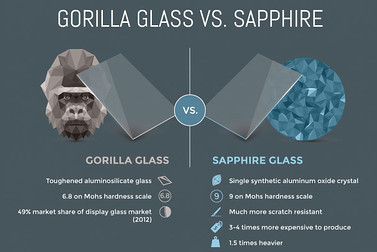Gorilla Glass vs. Sapphire Glass: Why Apple Chose to Stay With Gorilla Glass on iPhone 6
 On the 9th of this month Apple revealed the official specs of the iPhone 6 at their special event in Cupertino, California. One of the most surprising announcements made was that the iPhone 6 would not be getting an "ultra-durable" sapphire screen after all.
On the 9th of this month Apple revealed the official specs of the iPhone 6 at their special event in Cupertino, California. One of the most surprising announcements made was that the iPhone 6 would not be getting an "ultra-durable" sapphire screen after all.
For months rumors have been circulating that the iPhone 6 would have a display made of an incredible new crystal sapphire material. Forbes even did a story reviewing the upcoming display as if it had already been announced.
To the surprise of many, we've now learned that the Cupertino-based tech giant has chosen to stick with the well-known Gorilla Glass that it has been using since the first iPhone was released in 2007.
Why Did Everyone Think the iPhone 6 Was Going to Have a Sapphire Display?
We've already covered the fact that Apple has partnered with GT Technologies within the past year, apparently paying the company to manufacture a high volume of sapphire glass. Much speculation has been made about the purpose of Apple's relationship with GT Technologies, with many analysts now believing that the partnership was established to produce sapphire glass for the iWatch instead of the iPhone 6.
So many people were convinced that the iPhone 6 would have a sapphire screen that an analyst at TIME magazine wrote a story on it (which has since been updated). In summary, everyone thought it was a safe bet to expect a sapphire screen after Apple purchased more than $578 million worth of the material from GT Technologies this year.
So What Happened, and Why Did Apple Back Out on Sapphire?
With so many people expecting to see an “indestructible” screen on the iPhone 6, it is very surprising that we're actually seeing the opposite in the durability department, with the larger iPhone 6 Plus giving way to bending due to its highly flexible aluminum casing. So why, did Apple not only opt for a bendable aluminum casing, but also back away from the supposedly indestructible sapphire glass? There are numerous reasons, including but not limited to:
-
Sapphire costs about 10x more to make than glass, which would add extra cost to the price of each iPhone 6
-
Sapphire glass is thicker than Gorilla Glass, which can present a problem by being too bulky for some screens
-
Sapphire screens are worse for battery life because more energy is needed to make light travel through its thicker surface.
-
Finally, the biggest problem is that testing has revealed that sapphire glass is actually more likely to crack than Gorilla Glass. It turns out that while sapphire is very difficult to scratch, it is actually 3-4 times more likely to develop a crack if dropped.
With all of that said, it seemed to be a better business decision for Apple to stick with the tried and true Gorilla Glass. However, sapphire glass is still used in the iPhone's camera lens, as it is very difficult to scratch, and it is also being used for some iWatches (as obviously watches are less likely to be dropped).
